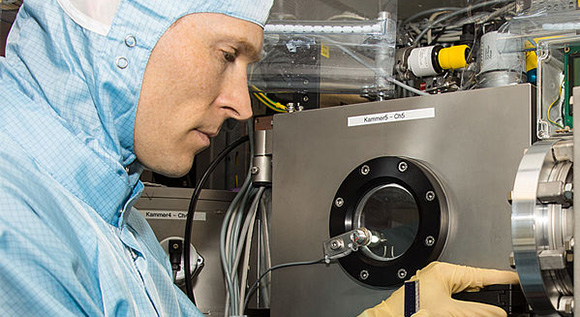Solar energy – ever faster and ever more efficient
The Baden-Württemberg Centre for Solar Energy and Hydrogen Research (ZSW) has set a new efficiency record for thin-film solar cells of 22.6 per cent. What is also impressive is that the past three years have seen several all-time records in solar cell efficiency set – right across the globe.
 © Baden-Württemberg Centre for Solar Energy and Hydrogen Research (ZSW)
© Baden-Württemberg Centre for Solar Energy and Hydrogen Research (ZSW)
Solar cells smaller than a fingerprint are big enough for world records to be broken. Just a few weeks ago, researchers at the Baden-Württemberg Centre for Solar Energy and Hydrogen Research (ZSW) set a new efficiency record for thin-film solar cells. It was here that they created a solar cell that has a surface of just half a square centimetre, but has an efficiency rate of 22.6 per cent – surpassing the former leading technology from Japan by 0.3 percentage points.
Thin-film solar cells can be used as an alternative to the more commonly used silicon wafer solar cells. Whilst current thin-film solar cells have yet to become as efficient as their competitors, they also offer clear benefits. They are cheaper to produce, more light-weight, and can be manufactured using fewer resources. The next challenge to be mastered is to scale up production, with work on this already progressing well.
Records being broken at an ever-faster pace
With efficiency rates in photovoltaics increasing exponentially, it is likely that the next record is not too far away. The past three years alone have seen faster improvements in efficiency rates for thin-film solar cells, which are made of copper indium gallium selenide (CIGS), than the fifteen years previous.
Between 1998 and 2013, new records were only achieved every two to three years. On average, efficiency rates used to improve by 0.1 to 0.3 percentage points per year. Today, the comparative figure is just under 0.7 per cent – which means that world records are being broken every semester. Just a few months ago, the European efficiency record stood at 22 per cent. The scientists from the ZSW think that it is entire possible that the 25 per cent efficiency mark could be reached in just a few years’ time from now.
Better efficiency, cheaper solar power
The fast development seen in solar-cell efficiency is likely to benefit consumers as well, with higher efficiency rates bringing down the cost of solar power. This is an effect that can already be observed on a global scale. According to the International Renewable Energy Agency (IRENA), solar power now accounts for two per cent of global power generation. By 2030, this figure could go on to rise to 13 per cent – particularly as a result of falling prices.

